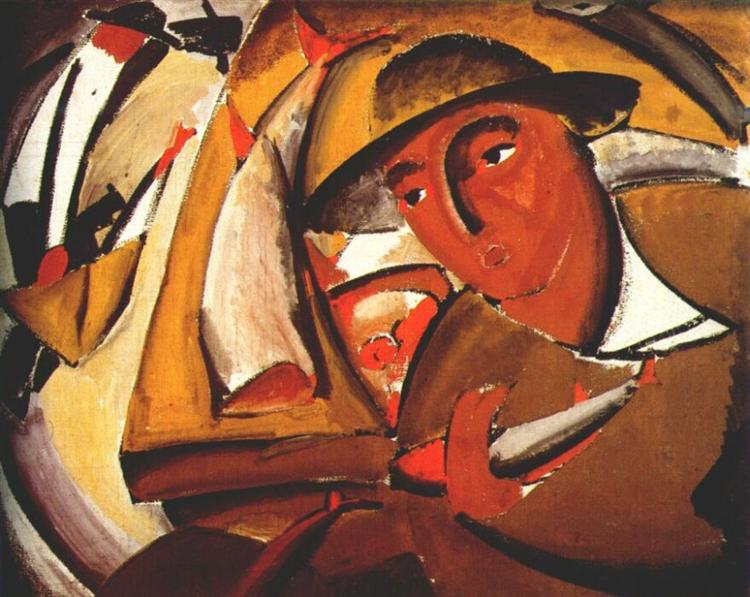Description
The painting "The Pescadero" of Vladimir Tatlin, created in 1911, is a work that captures a daily scene with a visual and conceptual complexity that anticipates the innovations that would characterize the artist's career. Tatlin, a prominent figure in Russian constructivism, already demonstrates in this early stage of his career his ability to break with the artistic conventions of the past and explore new forms of representation.
The composition of "El Pescadero" stands out for its geometric structure and its use of space. The central protagonist, a fishmonger in his work environment, is integrated into a game of plans and shapes that fragments immediate reality. The figure of the fishmonger, with his dark outfit and his face partially veiled by shadows, is absorbed in his work, outside the observer, which gives the work a feeling of authenticity and humanity. The work table, full of fish and utensils, serves as a focal point that anchors the composition and guides the viewer's gaze through the scene.
The use of color in paint is another remarkable aspect. Tatlin uses a palette that goes from dark and terrible tones to more vivid and contrasting colors. The red and blue are intertwined with brown and gray, creating a chromatic dynamism that suggests movement and life within a predominantly static atmosphere. This contrast between movement and stillness can be interpreted as a metaphor of the artistic process of Tatlin, who constantly sought the balance between tradition and innovation.
Tatlin demonstrates in "El Pescadero" an admirable capacity for detail and texture. The representation of the fish, with their bright scales and curved bodies, adds a tactile dimension to the work. Each object, from fish to work instruments, is rendered with thorough care that invites the observer to appreciate the most material and tangible aspects of the scene.
The historical context of this painting is also relevant. Created in the preamble of the Russian Revolution, "The Pescadero" reflects an exploration and transition phase in Russian art. Tatlin, influenced by Italian futurism and the new European artistic currents, begins to uncheck the purely figurative to enter a land where the form and function begin to converge. Throughout his career, this search would lead him to more radical proposals, such as his famous Tatlin Tower, a symbol of constructivism and technological utopia.
Compared to other works of the same period, "El Pescadero" stands out for its almost poetic approach to a common theme. While colleagues like Malevich and Rodchenko were oriented towards total abstraction, Tatlin remained anchored in the field, perceiving in everyday life the possibility of aesthetic expression. This duality between the concrete and the conceptual is what gives the work a unique depth.
In summary, "The Pescadero" of Vladimir Tatlin is not only a daily representation and life, but also a premonition of the author's future artistic-conceptual explorations. It is a work that, through its meticulous composition, its color palette and its detail, invites observers to immerse themselves in the Dialectic Universe of Tatlin, where the palpable reality is intertwined with a persistent search for new ways of seeing and representing the world.
KUADROS ©, a famous paint on your wall.
Hand-made oil painting reproductions, with the quality of professional artists and the distinctive seal of KUADROS ©.
Art reproduction service with satisfaction guarantee. If you are not completely satisfied with the replica of your painting, we refund your money 100%.

